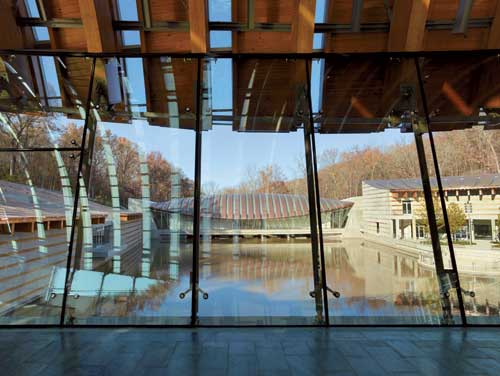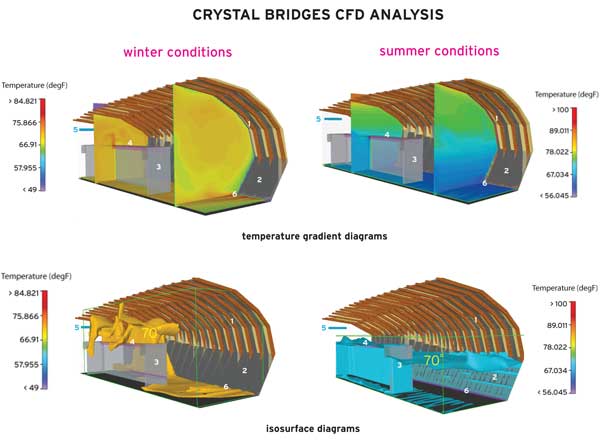Performance Puzzle
Reconciling a project's architectural aims with its conservation requirements often involves imaginative solutions and thorough analysis. Such was the case at the just-completed Crystal Bridges Museum of American Art in Bentonville, Arkansas, which houses the collection of Walmart heiress Alice Walton. Designed by Moshe Safdie, the 200,000-square-foot assemblage of linked pavilions sits in a wooded ravine alongside a dammed stream. Two of the pavilions, which have inclined glass walls and cable-supported, glass-and-copper roofs framed by glue-laminated arches, span the stream. Safdie has designated one as a restaurant and the other as an exhibition space, despite the quantity of glazing. Within this gallery-bridge, he inserted two drywall boxes with fabric-scrim ceilings. The arrangement provides wall surfaces for display and helps limit the artworks' exposure to sunlight. It also, says Safdie, allows museumgoers to take in the natural setting as they move from gallery to gallery.
|
||
| Suspended Span: Crystal Bridges Museum of American Art includes a primarily glass-enclosed bridge pavilion that serves as an exhibition space (background, bottom). Its interior includes drywall boxes for art display. Using computational tools, engineers studied the potential for temperature stratification and the flow of air around the boxes under worst-case winter and summer conditions. Because the bridge is symmetrical, they modeled only one quadrant, saving calculation time. |
||
Diagrams courtesy Buro Happold |
 |
Photo © Timothy Hursley |
Engineers made the most of the resulting circulation area between the boxes and the bridge's sloped glass walls, putting it to use as a climatic buffer zone. Here, temperature and humidity levels could vary beyond the narrow range permitted in the galleries, explains Niall Cooper, associate principal at Buro Happold, the project's structural and mechanical consultants.
To coordinate the systems in the circulation zone with those of the gallery boxes, and to ensure the right conditions for both people and art, the engineers used several types of tools, including computational fluid dynamics (CFD)–an analysis of fluid-flow, heat-transfer, and other phenomena by means of computer-based simulation. The studies identified several potential vulnerabilities, including winter downdraft conditions that could lead to the formation of condensation. For the final design, engineers were then able to tune the temperature, direction, and velocity of air supplied to both the galleries and circulation space to avoid such problems. The methodology allowed Safdie to maintain the desired connection to the landscape while keeping energy use in check. Or, as Cooper explains: "It facilitated the architectural vision."









